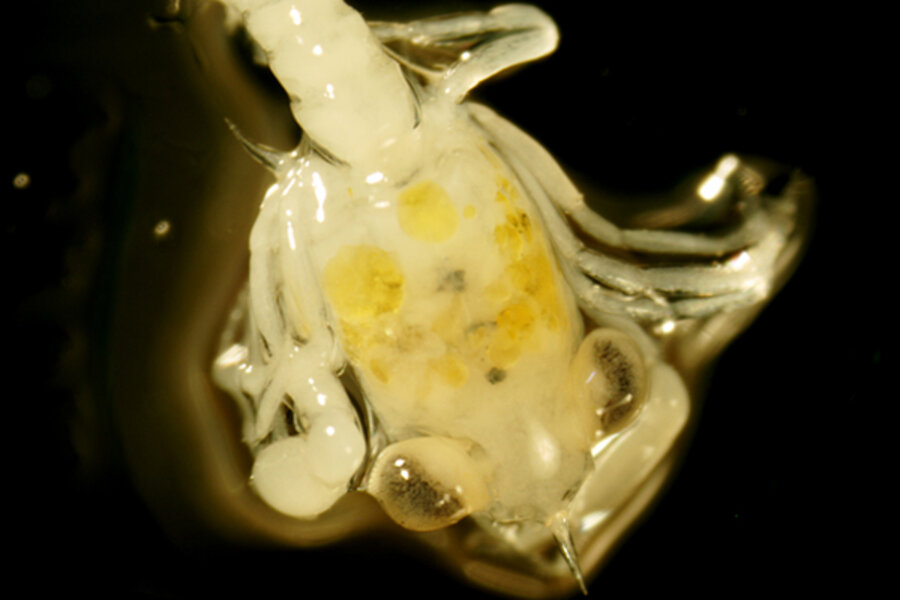Gulf oil spill to blame for oily blobs in vital Gulf sea life?
Loading...
| New Orleans
To find out how the food chain has been affected by the Gulf oil spill, marine scientists are closely monitoring this year’s spawn of blue crab – a key kind of plankton – in the Gulf of Mexico.
In late May, marine biologist Erin Grey, a post-doctoral researcher at Tulane University, discovered oily orange droplets inside blue crab larvae she collected in areas affected by the BP oil spill.
Eighty percent of crab larvae samples collected from an area of the Gulf stretching from Louisiana to Florida showed evidence of the orange substance, which initially tested positive for hydrocarbons, says Dr. Grey, who along with other Tulane researchers, is collaborating with the University of Southern Mississippi’s Gulf Coast Research Laboratory.
More blue crab larvae with the orange blobs were recently collected off Grand Isle in Louisiana, she adds.
“This is something that researchers with decades of experience have never seen before, and we think it must be linked to the spill,” says Grey.
Subsequent testing, however, has yet to give a definitive answer on whether the unusual substance contains either oil or dispersants related to the oil spill, she says. “It’s been frustrating because you want answers, and initial analyses said, 'Yes, it’s hydrocarbons,' but we still haven’t gotten a clear enough reading to say for sure,” she adds.
Importance of blue crabs
Blue crabs are an important commercial species accounting for nearly $300 million in economic activity in Louisiana alone. Oil inside blue crab larvae could mean a disruption of the fishing industry. It could also be a worrying sign that the spill is affecting the reproductive cycles of a number of plankton species at the base of the Gulf’s food web.
“Since almost Day 1 of the spill, there have been grave concerns about how plankton life in the Gulf will be affected,” says Robert Thomas, director of the
Center for Environmental Communications at Loyola University. “Answers to those questions could mean a lot to the future of the Gulf, and the public is dealing with a lot of speculation these days.”
Reports of the possible discovery of oil in blue crab larvae prompted an immediate response by the National Oceanic and Atmospheric Administration. Initial screenings by NOAA scientists have not found the unusual orange droplets or other signs of oil in blue crab larvae, says John Lamkin, a fisheries scientist with NOAA.
In late May, Mr. Lamkin was concluding an annual NOAA research cruise collecting plankton samples from the Gulf for an on-going study of blue fin tuna. His team kept four plankton samples from that cruise and then made plans for a second research trip in the northeast Gulf.
That cruise was completed in early August. A third cruise will start next week, he says.
Results to come
While the initial samples did not show up the droplets, more definitive answers will take months, Lamkin says. “When you tow for plankton samples … you end up with thousands … of little animals and you have to sort the entire sample,” explains Lamkin, adding that NOAA sends its samples to a laboratory in Poland for separation. “It will be some months before we know whether what some other researchers are reporting is happening on a broad scale.”
Grey and other researchers are continuing their own research.
In summer months, female blue crabs release millions of eggs in estuaries, which float on currents into Gulf waters. The larvae mature offshore for a number a weeks before swimming back inshore as juvenile crabs.
“Juvenile blue crabs should be swimming back over the next couple of months in the hundreds of millions, so if we don’t see that we know the spill has affected them,” Grey says.





